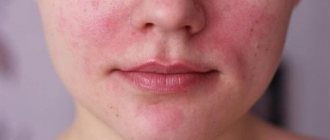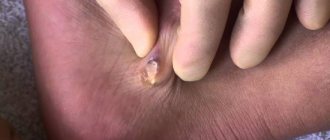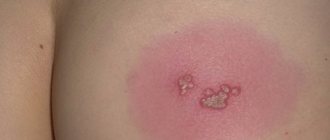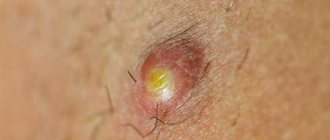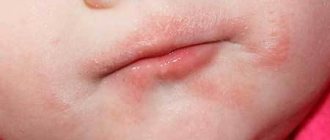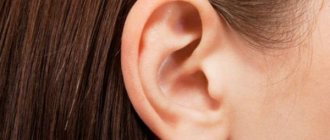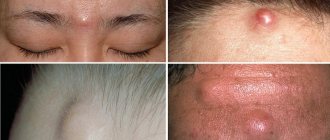Eczema on the buttocks. Causes
There is practically no place on human skin where eczema cannot appear. In addition, its prevalence is up to 40% of all skin diseases. All age groups are susceptible to it; parents are especially concerned about eczema on the baby’s bottom. However, such a frequency of cases of eczema, the severity of the clinical course of the disease, and resistance to treatment have not brought medical science any closer to a clear understanding of the causes of its occurrence.
It was possible to establish that a hereditary factor plays a certain role. The risk of developing eczema on the butt in a child is 40% if his mother had this problem and 60% if his mother and father suffered.
Against the background of a genetically determined breakdown, infectious, allergic, endocrine, metabolic, vegetative-vascular, and immunological factors acquire fatal significance.
Why is eczema on a child’s bottom more common than on an adult? An important role is played by the functional immaturity of the gastrointestinal tract and hepatobiliary system, the imperfection of the intestinal barrier, which allows undigested protein to be absorbed into the blood. Cells of the immune system, T-lymphocytes, have specific receptors for binding antigen, releasing special substances, cytokines, that cause a tissue inflammatory response. This is an endogenous component of the causes of eczema on the bottom of a child.
Exogenous factors are diverse - chemical, microbial, medicinal, biological. Upon contact with them, a delayed-type hypersensitivity mechanism is triggered. Eczema often appears on the cheeks of children. The old name for reddened baby cheeks is “diathesis” and it is more common in bottle-fed children.
There may be manifestations in the elbow and knee bends, in the groin area. These are areas of increased sweating, the appearance of diaper rash, and also in contact with diapers or underwear.
Adults are more likely to suffer from another type of eczema - eczema of the anus. This is a proctological disease, the causes of which are not precisely known. Predisposed to it:
- dilated hemorrhoidal veins;
- diabetes;
- excess weight;
- increased sweating;
- anal sex;
- inflammation of the prostate, uterine appendages;
- decreased immunity and increased fungal activity;
- stomach dysfunction, problems with bowel movements;
- violations of intimate hygiene;
- hair removal and shaving without following processing rules;
- rough toilet paper;
- tight underwear.
Find out more
In what cases should you consult a doctor?
If dry skin is a consequence of microclimate disturbances, caused by the aggressive effects of household chemicals and cosmetics, or occurs as a result of dehydration, and after correcting the diet, drinking regime, care and atmosphere in the room, the functions of the epidermis are completely restored, there is no reason for concern and it is not necessary to consult a doctor .
If dry skin on the thighs and buttocks was not caused by external causes and its condition does not improve significantly even after using moisturizers, it may be one of the first symptoms of the following diseases:
- neuralgia of various origins;
- hypothyroidism;
- diabetes mellitus;
- varicose veins;
- deep vein thrombosis;
- psoriasis;
- atopic dermatitis;
- neurodermatitis;
- hormonal disorders.
An undoubted reason to consult a doctor will be the presence of rashes, ulcers, non-healing wounds and pigmentation disorders on the skin.
Symptoms of eczema on the buttocks
The process of development of eczema on the buttocks is characterized by stages (see photo).
- An area of reddened and swollen skin appears, which is accompanied by burning and itching, which intensifies in the evening. The child is restless and does not sleep well.
- Pink-red bubbles appear.
- The nodules are replaced by vesicles with serous contents.
- The bubbles open, moving into the weeping stage.
- Drying begins with the formation of crusts.
- The crusts peel off and fall off, revealing healthy skin underneath.
In one area of eczema on a child’s bottom, you can see false polymorphism in the photo, that is, elements belonging to different stages.
Delayed treatment leads to the spread of the process. A complication that causes excruciating pain - eczema between the buttocks of a child is shown in the photo. Each act of defecation becomes painful, after which careful hygienic procedures are necessary.
The presented photo shows that the primary location of eczema is possible in the anus. Patients complain of itching, burning in the anus, pain during bowel movements. This leads to irritability and depressive disorders. A detailed examination often reveals helminths in such patients.
Excruciating itching leads to scratching and additional damage to the skin, which can lead to a secondary infection. Symptoms of general intoxication appear:
- temperature;
- weakness, malaise;
- sleep disorders;
- headache;
- migraine;
- decreased appetite;
- nausea.
The discharge takes on a purulent greenish character with a putrid odor. There is an increase in regional lymph nodes.
Chronic eczema is not characterized by weeping. The skin is dry, cracking, and the pigmentation of the dermis is disturbed. The itching does not stop, leading the patient to stress.
Diagnosis of eczema on the buttocks in adults and children is based on a survey and examination of the patient, general clinical laboratory examination, culture and biopsy sampling according to indications, examination for fungal infection, and identification of allergens.
When a purulent infection is attached, differential diagnosis with pyoderma, toxicoderma, streptoderma, and atopic dermatitis is required. The photos presented in the article will help to distinguish eczema on the butt in adults and children from other diseases in this area. It is important to remember that the main distinguishing symptom of eczema is unbearable itching.
In severe cases, hospitalization of the patient is required.
Types of buttock rashes
Types of buttock rashes:
- Papules (nodules). Dense nodular formations of red color, slightly rising above the skin. They are considered inflammatory pimples (according to classification). Accompanied by painful sensations and itching. This rash causes a lot of discomfort to its wearer.
- Common spots (pigment spots). This type of rash affects the superficial layers of the epidermis. They come in different shades: from white to dark brown. Buttock rashes are often red and burgundy in color.
- Scales. They are secondary elements of the skin, itchy and flaky. They are formed by layering cells on top of each other. Occurs in fungal diseases, psoriasis.
- Pustules (ulcers). Cavities filled with purulent contents. Pustules can affect both the superficial layers of the skin and the deep ones.
- Vesicles (water blisters). They appear in the form of small formations (bubbles) with a rough structure protruding above the epidermis. Interstitial fluid accumulates in them due to friction of the affected skin areas with clothing. They can also be the result of viral and bacterial infections.
- Acne. Such rashes occur due to blockage of the sebaceous glands. The formed seals on the skin are inflammatory in nature. If you squeeze them a little, the dark contents will stand out.
Treatment of eczema on the buttocks and buttocks
The answer to the question of how to treat eczema on the butt depends on:
- localization of the process (buttocks, around the anus or in the anus, in the intergluteal fold);
- patient's age (adult or child);
- stage and type of eczema.
Treatment should be comprehensive, using many therapeutic factors, but at the same time individual.
The complex for the treatment of eczema on the buttocks involves:
- dermatologist;
- pediatrician;
- immunologist;
- neuropsychiatrist;
- nutritionist;
- allergist;
- gastroenterologist;
- proctologist
Treatment of eczema on the buttocks with medications
Before you start treating eczema on a child’s bottom, you should remember that the child’s body should not be overly loaded with medications. In children they use:
- oral antihistamines (Zyrtec, Zodak);
- enterosorbents (Polifepan, Polysorb);
- corticosteroids in severe cases;
- local disinfectant and antipruritic ointments (Topicrem, Atopic, Fenistil-gel);
- antibacterial ointments for complicated eczema.
Treatment is prescribed by a dermatologist.
Treatment of anal eczema is much more difficult since the transition to a chronic form occurs quickly.
The following drugs are used to treat adults:
- antihistamines Claritin, Cetrin;
- sedatives, soothing itching and improving sleep (Sedasen);
- for purulent complications, broad-spectrum antibiotics from the group of cephalosporins, fluoroquinolones, macrolides;
- anthelmintics according to indications;
- ointments (Losterin based on naphthalan) and hormonal (Lokoid) are applied topically;
- The combination drug Proctozol has proven itself well.
Particular attention is paid to identifying and eliminating the provoking factor; without this, success from the therapy will have to wait a long time.
It is recommended to add physiotherapy to medications. Laser, UV irradiation, electrophoresis, bioresonance are effective.
Sea bathing is beneficial.
Treatment of eczema on the buttocks and butt with folk remedies
Safe and acceptable means of traditional medicine for use in the youngest patients are washing with herbal decoctions. The most common are chamomile, oak bark, string, calendula, St. John's wort. This procedure must be carried out at least 5-6 times a day, including after each bowel movement. It is advisable to apply a compress for an hour.
Unusual advice is also offered. An example is pure technical grease, especially with a positive result from the use of ointments with medical grease. It is applied to the skin in a thin layer, left for 10 minutes, gradually increasing the exposure to an hour, or even using a compress at night. After grease, wash the skin with tar soap.
It is recommended to prepare an oil extract from St. John's wort flowers.
Pine oil can be prepared from pine needles collected in March. The crushed needles are poured with vegetable oil and left in the dark for at least 2-3 weeks. This oil accelerates the healing of cracks and eliminates dryness.
You can prepare propolis oil at home. It is prepared in a water bath in a ratio of 100 g. butter 15 gr. propolis.
Treatment is simple and cheap by applying a paste of freshly grated raw potatoes.
Infectious manifestations
Photos of rashes on the buttocks due to infectious diseases look unattractive; the most common pathologies of this class include the following:
- Syphilis is a sexually transmitted disease, at stage 2 it affects the entire body, incl. and buttocks. Usually the rash is localized perianally. It is symmetrical, often papular, spotted, does not cause any sensations and goes away on its own after 2 months. Further, as we move into stage 3, it appears again, but in smaller quantities.
- Dermatophytosis is a fungal infection. Manifested by the appearance of scutulles on the butt.
- Pityriasis versicolor is also a fungus that develops with excessive sweating. Yellow-brown dots first form around the hair follicles, followed by scalloped spots with peeling and itching.
- Molluscum contagiosum is a viral infection from the smallpox group. It appears as shiny translucent nodules with an indentation in the center. The size is up to a pea, they are grayish or pink, without itching. When squeezed, a white pulp is squeezed out.
- Herpes - caused by HSV type 2, less often type 1. In women it manifests itself more often on the genitals, in men - a rash on the buttocks. Groups of bubbles (vesicles) appear with itching and swelling. After a couple of days, they break through and turn into ulcers. The liquid becomes cloudy, the ulcers become covered with yellow or brown crusts. The disease is highly contagious through physical contact.
- Rubrophytosis is a rash of fungal origin. Small red blisters with itching are observed over the entire surface of the buttocks.
- Genital warts are caused by the HPV virus. Reminds me of warts. They like to settle on the genitals and buttocks. Externally, the formations look like cauliflower, soft, moist, itchy. They grow very quickly, in 3-4 hours they grow into a whole colony.
- Lichen planus is a fungal disease. This disease causes a rash to appear on the buttocks, legs (inner thighs), genitals and arms. The rash on the butt can look like rings, chains, or garlands. These nodules are very itchy and painful.
- Scabies is caused by the scabies mite, which forms tunnels in the skin. Accompanied by the appearance of blisters and blisters with severe itching. The subcutaneous passages are slightly elevated, they are up to 1 cm long, gray in color. Bubbles are the end of moves. At night the itching intensifies.
How to remove dark spots between legs
Dark spots can appear not only between the legs, but also in the armpits and around the anus.
Sometimes pigmentation disappears on its own after a while, but most often girls are looking for ways to lighten their intimate areas.
Causes of dark spots between legs
One of the main reasons is excess weight. While walking, the thighs rub against each other, abrasions and redness appear, the skin becomes rough and dark.
Discomfort can be caused by synthetic items, narrow nylon tights, which do not allow air to pass through and increase sweating. Wear cotton, loose clothing, make sure that things do not restrict movement and are selected in size.
Not only overweight people can experience chafing or dark spots on the inner thighs - athletes also have problems due to improperly selected clothing.
Tight sweatpants that have rough inner seams can cause a lot of chafing on your legs when you exercise regularly.
Incorrect depilation
Think about whether you are shaving your bikini area correctly? You may be using the wrong depilatory cream or you may be injuring your skin while shaving.
A good product for removing excess hair can be found here (I took the cream for myself, I really liked it, it has an effect).
Any hygiene products can cause irritation, and pigmentation increases to protect the area from damage.
Too frequent visits to the solarium can also cause severe darkening of the skin.
Dark spots on the skin can appear not only due to external influences, but also due to internal changes in the body.
Skin darkening is affected by:
- Failure of hormones due to age (menopause);
- heredity;
- structural features of the body (legs are too close);
- thyroid disease, diabetes, varicose veins (skin color is restored after treatment);
- fungal diseases (only treated by a dermatologist);
- sometimes the skin darkens during menstrual periods;
- Darkening of the skin is not uncommon during pregnancy - hormones are raging, and the area of the abdomen and nipples may darken.
How to whiten spots on inner thighs
They say that Rexsona roll-on deodorant, talc, starch (used as a regular powder) or regular tan help against stains and abrasions.
At the same time as the tan, unsightly dark spots disappear.
Again, I advise you to look at the lightening cream on a well-known website (I will not advertise it). I liked that it contains collagen, and the skin not only whitens, but also receives intense hydration. I have very dry skin, which is a plus. I think that for the low cost the cream does its job 100%. For those interested, you can see the whitening cream here.
Various powders will only help if the body does not sweat. The effect is short-lived - 2-3 hours, so many women carry a jar of talc in their purse just in case.
Lemon juice for age spots
You can whiten dark spots on the inner thighs with lemon juice. It is enough to sometimes wipe problem areas with a cotton pad soaked in juice.
Another option: cut a lemon into two halves and rub it into your skin.
Lemon juice can be mixed with natural yogurt (1:1) or coffee grounds. Drain the coffee, mix the grounds remaining at the bottom with lemon juice (40 ml). Do not keep the mixture on your skin for more than 4-5 minutes.
Mix lemon juice (1 tsp), honey (1 tsp), milk powder (1 tsp) until smooth, add almond oil (1-2 drops). Apply the mixture to the skin, rinse after 15-20 minutes.
Another option: add coconut oil (2 tablespoons) to lemon juice and rub the ointment into problem areas for 5-10 minutes. Coconut oil will soften the effect of citric acid and moisturize the skin.
Aloe juice whitens and soothes the skin. To avoid causing irritation, it is better to dilute with water (1:1).
Fresh cucumber has a whitening effect. Cut the vegetable into thin circles, place on the inner side of the thigh, and remove after 10-15 minutes. The cucumber can be grated and mixed with baby cream.
Yogurt with oatmeal. Mix 1 tsp. oatmeal, yogurt and lemon juice. Apply the paste to problem areas and wait until dry. Oatmeal scrub will remove dead skin particles and relieve inflammation.
Oatmeal can be mixed with tomato juice (2 tbsp). The mask can be done 3 times a week.
According to reviews on the Internet, it is recommended to rub the inner side of the thigh with a crust of black bread or lubricate it with parsley decoction: squeeze the juice from the parsley root, mix with lemon juice and sour cream (1:1). Apply the mixture to dark areas, remove after 15-20 minutes.
Potato compress
Cut the potatoes into circles, you can grate them. Distribute the mixture on the inner thighs, leave for 20-25 minutes (until the paste darkens).
A good remedy is zinc ointment (it has no contraindications and is approved for pregnant women). Zinc oxide has a whitening effect; it contains petroleum jelly and paraffin.
Shark oil and sage cream soften the skin well, remove stains and abrasions between the legs.
Hips can be wiped with diluted vinegar essence. After 2-3 minutes, the skin should be thoroughly rinsed with water. Despite the fact that vinegar exfoliates dead skin particles well, you should not overuse the solution - you can get burned.
Honey with orange zest
Ascorbic acid in oranges lightens age spots well, and honey soothes and relieves irritation. Mix the zest of 1 orange with 1 tbsp. honey, apply to the inner thighs. Rinse off the product after 10-15 minutes.
Instead of zest, you can add 3-4 drops of orange essential oil.
Badyaga for dark spots in the intimate area
Dilute the powder with hydrogen peroxide (3%), stir until it becomes a viscous paste. Apply the mixture to the inner thighs and wash off after 15 minutes. It is advisable to rub the product into the skin with massage movements for several minutes.
There may be a slight burning sensation, but this is not scary. The procedure must be done once every 3 days. The spots disappear after 4-5 procedures. After application, treat the problem area with cream.
Peroxide should be used with caution - if you are highly sensitive or allergic, it can burn your skin.
